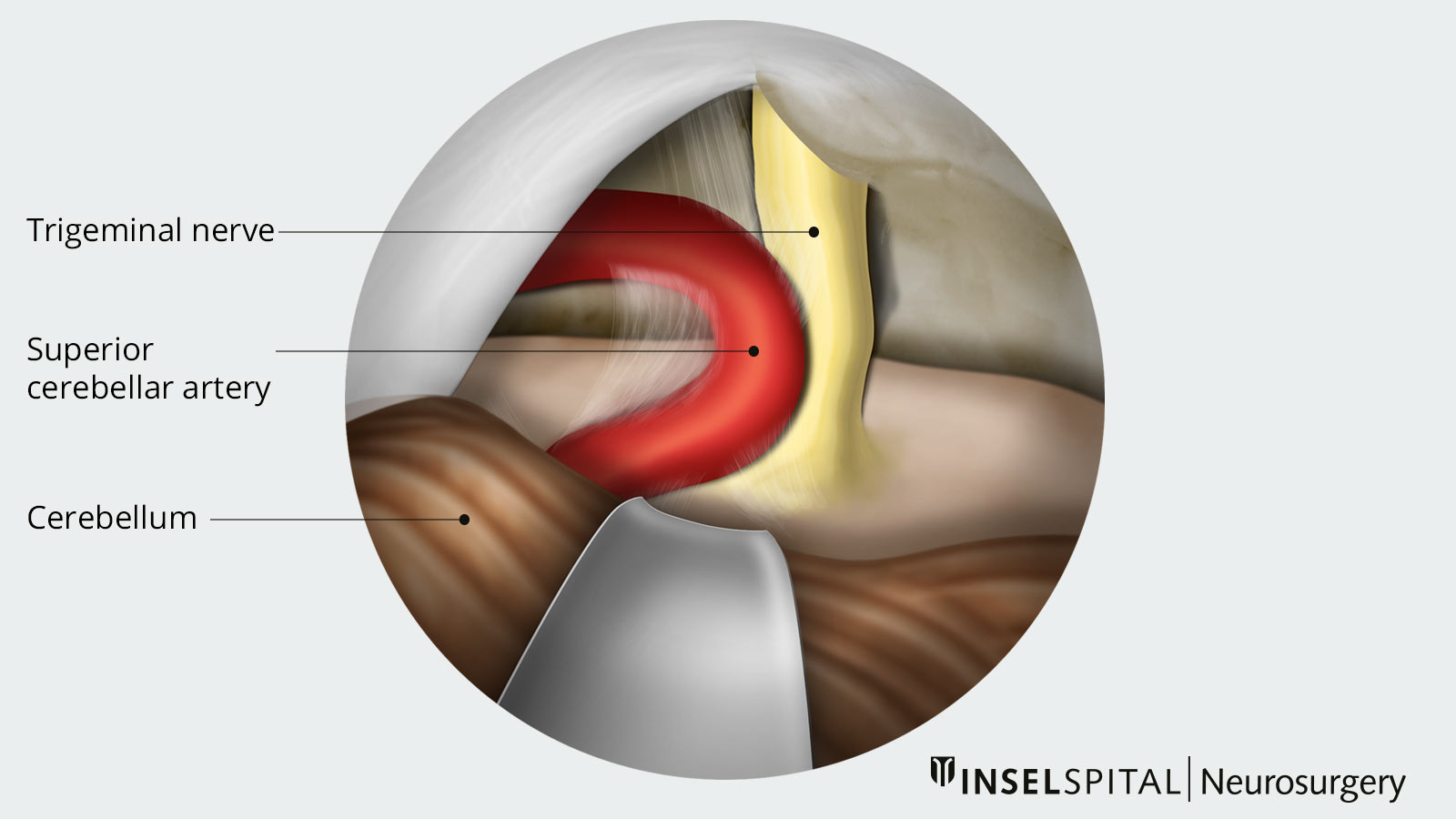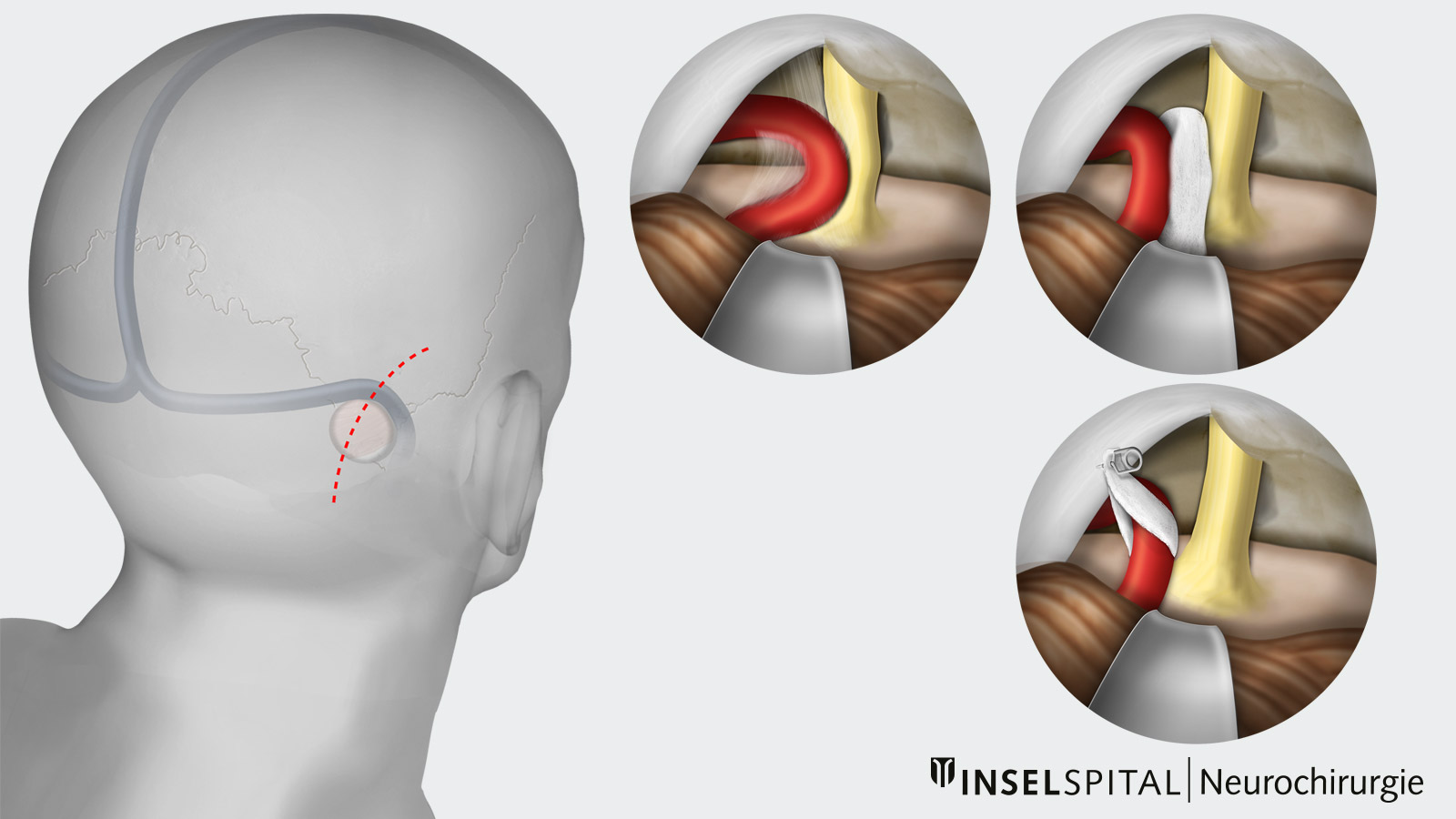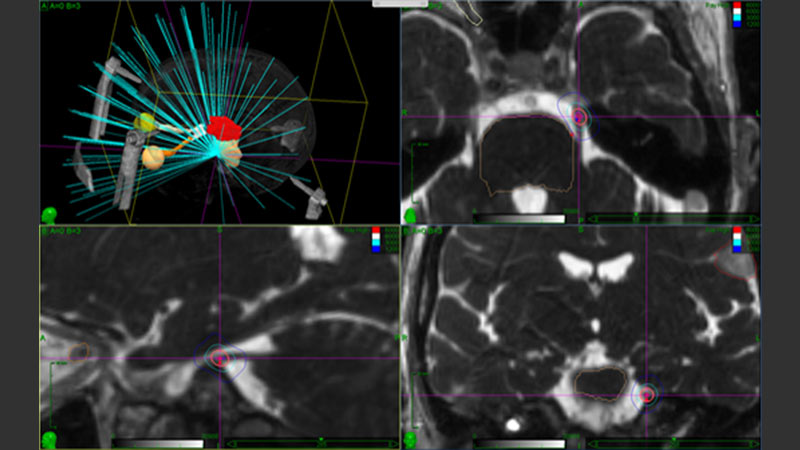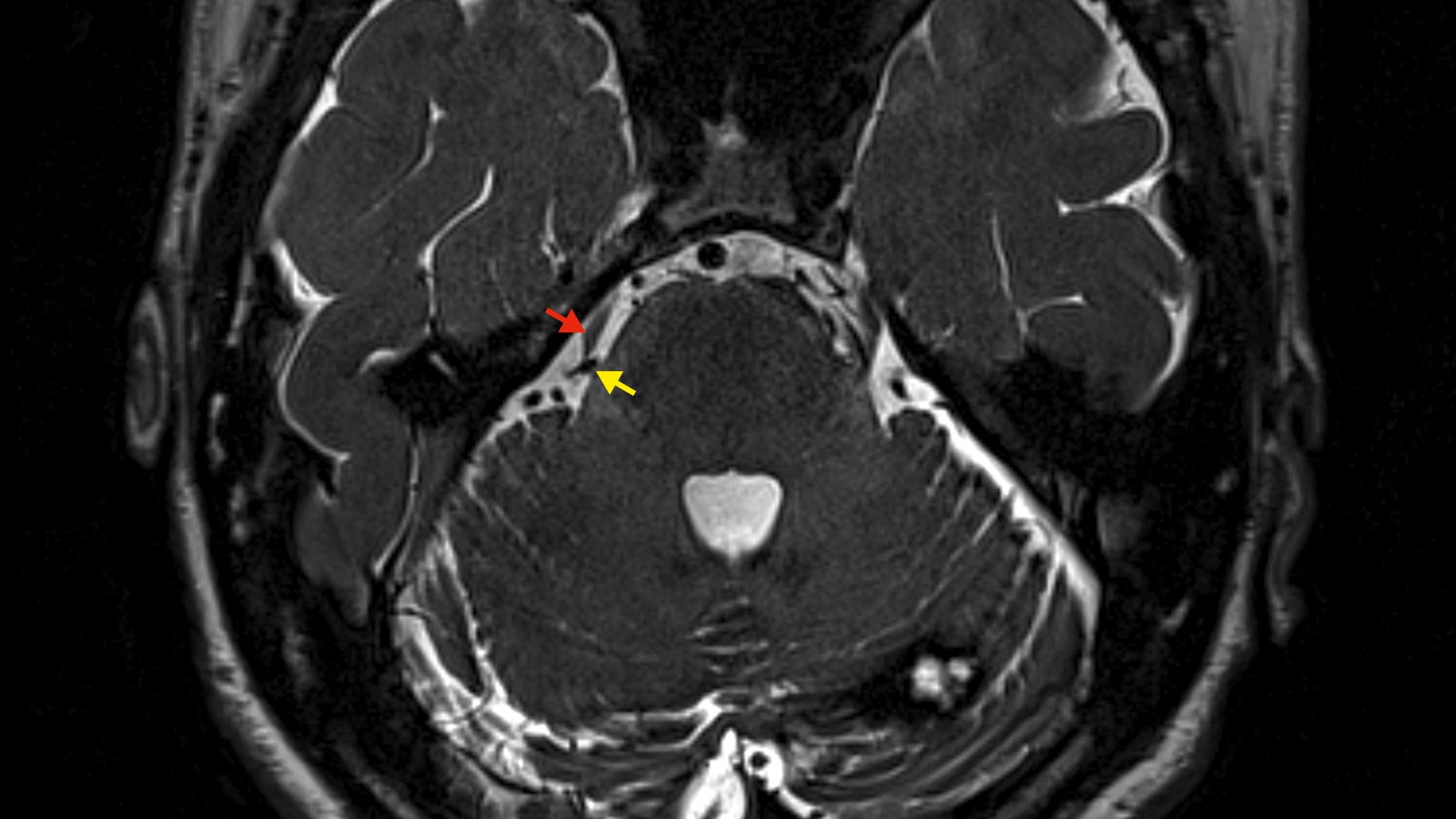Trigeminal neuralgia manifests itself as severe unilateral facial pain that starts in a flash and recurs repeatedly. The quality of life of those affected can be severely restricted as a result. The cause of this pain disorder is often a compression of the trigeminal nerve by an adjacent blood vessel. The diagnosis is made by means of magnetic resonance imaging. If the pain cannot be controlled purely by medication, several invasive treatment options are available.
How common is trigeminal neuralgia?
Trigeminal neuralgia is a relatively rare disease. The annual incidence of new cases is 10 : 100 000 persons. There are no specific risk groups for the disease, but women are significantly more often affected (at a ratio of 1.8 : 1). The disease reaches a peak incidence between the ages of 70 and 80.
What are the symptoms of trigeminal neuralgia?
Typical of trigeminal neuralgia is sudden onset, severe pain in the middle to lower half of the face. The pain can start up to 100 times a day, but always occurs on one side only. The single attack of pain is typically of very short duration (a few seconds), but may occur in multiple volleys. The interval between attacks is usually painless. Often, the pain attacks are triggered by stimuli such as speaking, chewing movements, drafts or touch.
Because the pain often radiates to the jaw, affected patients usually have had extensive dental work and treatment, including tooth extraction, before the condition is diagnosed.
In the course of the disease, patients may experience dull constant pain, which is due to small injuries of the nerve fibers, so-called axonal damage.
The intensity of the pain is very high in trigeminal neuralgia, so that those affected are usually massively restricted in their quality of life.

What are the causes of trigeminal neuralgia?
The trigeminal nerve (trigeminal nerve or 5th cranial nerve) is a nerve divided into three main branches. It carries both sensory fibers to supply the forehead and face and motor fibers for the muscles of mastication. Trigeminal neuralgia is a pain disorder in the area supplied by the sensitive nerve fibers. Most commonly, the pain radiates to the maxillary nerve (2nd nerve branch) and/or the mandibular nerve (3rd nerve branch); the ophthalmic nerve (1st nerve branch) is much less frequently affected.
In most cases, a neurovascular conflict, the so-called "Jannetta mechanism", is responsible for the complaints. This involves compression of the trigeminal nerve by a pulsatile blood vessel in the root entry zone, the nerve entry zone at the brainstem. Most commonly, this conflict occurs with the superior cerebellar artery or the inferior cerebellar artery. The pressure on the trigeminal nerve causes local demyelination, which means that the nerve cells lose their protective myelin sheaths at the pressure site. This leads to overexcitation of the sensitive nerve fibers and to a disturbance in signal transmission. The result is pain of high intensity shooting in like lightning.
Such a conflict cannot always be detected by imaging. Conversely, neurovascular conflict is relatively common but rarely results in trigeminal neuralgia.
In addition to classic trigeminal neuralgia, there is also symptomatic trigeminal neuralgia. In this form, the cause of the symptoms is another underlying disease, such as a tumor in the area of the nerve course, an inflammatory disease, or multiple sclerosis.

How is trigeminal neuralgia diagnosed?
Based on the typical symptoms, the diagnosis can often be assured. To exclude symptomatic trigeminal neuralgia, an MRI examination of the skull is performed. In addition, in special thin-slice sequences (CISS, IRTSE), the course of the nerve and a possible neurovascular conflict can be visualized in many cases.
Conservative treatment
Often, good pain relief or even freedom from pain can be achieved with drug treatment. Pregabalin (Lyrica), carbamazepine (Tegreteol), gabapentin (Neurontin), and baclofen (Lioresal) are common medications for this. Usually, one starts with a low dosage, which is increased in the course. In some cases, a combination of different drugs is also necessary.
If conservative drug treatment does not provide sufficient pain relief or side effects occur, invasive treatment may be considered.
Microvascular decompression (Jannetta surgery)
When drug therapy fails, microsurgical exposure and decompression of the trigeminal nerve are the treatment of choice for classic trigeminal neuralgia. This involves opening the skull via a retrosigmoidal approach. The cerebellum is retracted slightly so that the brainstem and the outgoing trigeminal nerve are visible at depth. The site of compression can then be visualized under the microscope or, in more complex cases, with the neuroendoscope. Even if there has been no clear neurocompression on the MRI image, it can often be detected during surgery. The compressing vessel is dissected off in the next step and permanently kept away from the nerve by fine Teflon.

Balloon compression
Balloon compression is an invasive, nonsurgical treatment. It is used in patients who do not respond to medical therapy or who have an increased risk of surgery or anesthesia (e.g., due to advanced age or other pre-existing conditions). In addition, balloon compression may be considered in patients with symptomatic trigeminal neuralgia (e.g., multiple sclerosis) or recurrence after previously performed Jannetta microdecompression.
Balloon compression is performed under sterile conditions, under general anesthesia and in the operating room. Under X-ray control as well as with the use of navigation, a probe is advanced through the cheek and a balloon catheter is placed in the cavity around the ganglion Gasseri (nerve node of the trigeminal nerve). When the balloon is inflated for a few minutes, high pressure is created at this site, which selectively damages the pain fibers of the nerve that transmit pain information (A-delta fibers and C-fibers). Sensitive fibers are spared.

Stereotactic radiosurgery
Another possible treatment method is stereotactic radiosurgery, in which the trigeminal nerve is specifically irradiated. This treatment is performed on an outpatient basis in a single session. With the help of the CyberKnife or a Gamma-Knife, a targeted and millimeter-precise irradiation of the nerve is performed shortly before it enters the brain. As a result of this irradiation, remodeling occurs in the nerve within a few weeks, resulting in pain relief. With this treatment option, the sensory fibers for the face are preserved in most cases, but pain conduction is significantly reduced. The radiosurgery procedure is used for trigeminal neuralgia when other methods have already been tried and there is a relapse of symptoms.

What are the success rates of the operations?
After microvascular decompression, over 90 % of all patients report feeling a significant improvement immediately or even being pain-free. This result lasts for more than 10 years in 70 % of patients. The rate for severe complications with microsurgical decompression is low, approximately 1 %.
The success rate of radiosurgical treatment is up to 76 % for freedom from pain. This result lasts for about 60 over 3 years. The complication rate is very low and in most cases concerns a sensory disturbance in the face *.
The success rate of percutaneous balloon compression is approximately 70–90 %. However, the recurrence rate is higher than after microsurgical decompression *.
Why you should seek treatment at Inselspital
At Inselspital, the determination of therapy is made after a neurological examination and after evaluation of MRI images. All options are discussed with the patient and explained in detail. This is followed by the individual therapy recommendation. We offer the following therapy options:
After surgery, our patients are called for a follow-up visit, where a new neurological examination takes place and the current clinical condition is assessed.
Depending on the success of the treatment, the medication can be reduced or discontinued. If the treatment has not fully taken effect, further invasive therapy options may also be planned to achieve freedom from pain.
-
Berger I, Nayak N, Schuster J, Lee J, Stein S, Malhotra NR. Microvascular Decompression Versus Stereotactic Radiosurgery for Trigeminal Neuralgia: A Decision Analysis. Cureus. 2017;9(1):e1000.
-
Chin L, Regine WF. Principles and Practice of Stereotactic Radiosurgery. 2nd Edition. Springer-Verlag New-York. 2015.

